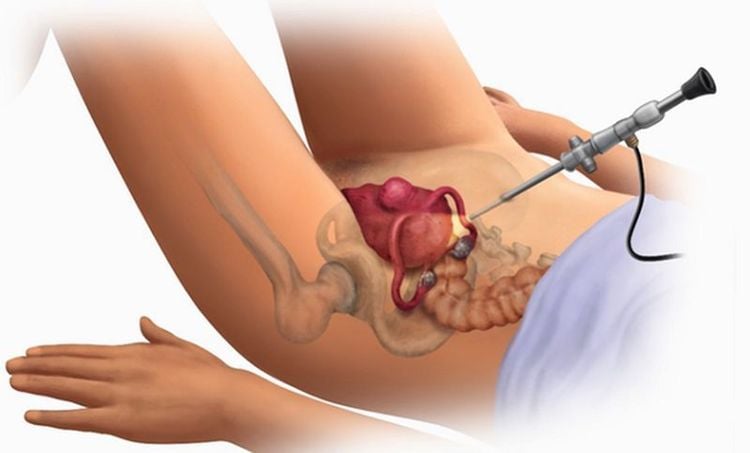This is an automatically translated article.
The article was consulted with Specialist Doctor I Le Thi Phuong - Obstetrician and Gynecologist - Department of Obstetrics and Gynecology, Vinmec Ha Long International General Hospital.Uterine prolapse can cause symptoms such as painful sex, a feeling of heaviness in the vagina. In some cases, mild uterine prolapse can be alleviated or reversed by performing pelvic floor exercises in conjunction with other self-care measures.
1. Symptoms of uterine prolapse
Uterine prolapse is a condition where the uterus is prolapsed and pushed into the vagina. This happens when the pelvic muscles and connective tissue become too weak to support the pelvic organs.
Uterine prolapse can appear in any woman, but the disease occurs more often in postpartum women, often exercising, carrying heavy loads, premenopausal women. Factors such as twin or multiple pregnancy, too large fetus, difficult delivery... will increase the risk of uterine prolapse after birth.
Mild prolapse usually has no symptoms. But when the uterus has prolapsed into the vagina, it can cause a variety of symptoms affecting the vagina, abdomen and lower back, such as:
Pain, pressure, a feeling of heaviness in the vagina. Urinate frequently. Difficulty urinating. Pain during sex. Bowel problems. Vaginal discharge or bleeding. Exercises for prolapsed uterus can ease symptoms. However, for severe prolapse, additional treatment may be required.
2. Exercises for people with uterine prolapse
Exercises for people with prolapse commonly used are pelvic floor exercises, also known as Kegel exercises. It is known to help strengthen the muscles and support the pelvic organs. Many studies show that pelvic floor exercises can reduce the condition and symptoms of uterine prolapse.
How to do Kegel exercises:
Sit with your back straight, feet on the floor and legs slightly apart. Lie down with your knees bent and feet on the bed or floor. Continue breathing normally. Pull up, tightening the muscles around the vagina as well as the anus so that the muscles are pressed in and up. Hold for 3 seconds. Relax for 3 seconds. Repeat up to 10 times. Do pelvic floor exercises 3 times a day. Increase the hold time by 1 second per day until you reach 10 seconds. If there is pain or leakage when sneezing, coughing or laughing, you should do the following:
Do the same exercise but only hold and relax for 1 second. Repeat this movement 10 times. Do Kegels 3 times a day for 6 months or until your doctor recommends another treatment. Too much kegels won't help and can even cause more problems, so don't overdo it. After 6 months, once daily may be enough to keep muscles in good shape. If you have trouble remembering Kegel exercises, you can use apps or get the help of a Kegel trainer to send reminders to help you stay motivated.

3. Exercises to avoid
Excessive physical exertion can aggravate prolapse. Therefore, you need to discuss with your doctor before doing activities that involve:
Jumping. Aerobics. Lift the weight.
4. Other uterine prolapse treatment options
4.1. Physical therapy Your doctor may refer you to a physical therapist for prolapse. Pelvic floor therapy can be tailored to your needs and monitored by therapists.
Biofeedback combined with a pelvic floor routine can ensure muscle contraction during exercise. This will help increase the effectiveness of the training process.
4.2. Pessary Pessary is a rubber-like device used to support the pelvic organs. They come in many shapes and sizes, so you can consult with your doctor to choose the right one for you.
You will also learn how to safely attach and remove it, and how to clean the device after use. Pessary can be used as a short- or long-term treatment.
4.3. Surgery Surgical options for uterine prolapse include:
Natural tissue repair: Sewing the prolapsed part to ligaments or muscles in the pelvis. Surgical mesh repair: When the tissues are not stiff enough, mesh is used to help hold the uterus in place. Surgical excision: This procedure narrows or closes the vagina to support prolapsed organs. However, after this surgery, it is not possible to have sex anymore. The uterus can slip when the pelvic muscles and connective tissue weaken and can no longer support them adequately. There are several reasons why this could happen, including:
Pregnancy. Vaginal or assisted delivery. Constipation or frequent straining. Chronic cough. Overweight and obesity. Lack of estrogen due to menopause. Old . Regularly lift heavy objects. High impact exercise. Over time, the severity of the prolapse can get worse.

5. Prevention of uterine prolapse
Some self-care measures can improve symptoms or prevent prolapse from getting worse. Specifically:
Avoid straining when having a bowel movement. Use a footrest to elevate your leg or lean forward to allow urine to pass easily. Eat a high-fiber diet and drink plenty of water to avoid constipation. Treatment of chronic cough. Do not lift heavy objects. Lose weight if you are overweight. Uterine prolapse does not always require medical intervention. But if it is, the treatment depends on factors such as:
Severity of symptoms. Age. Desire to keep your uterus. Other health concerns.
6. When to talk to a doctor
If the prolapse is mild, you may not have any symptoms. But see your doctor if:
Feeling of heaviness or pressure in the vagina. Pain during sex. Tiny. Difficulty urinating or having a bowel movement. Abnormal discharge or bleeding. Frequent urinary tract or vaginal infections. It is important to get the correct diagnosis because the symptoms of uterine prolapse are similar to those of the bladder, rectum, and vaginal vault.
When you go to the doctor, you can have a direct pelvic and rectal examination, and perform imaging tests to support the diagnosis. From the examination and laboratory results, the doctor will make conclusions and follow up instructions for you.
Currently, there are many different effective surgical methods to treat genital prolapse. Depending on the extent of the examination, the doctor will prescribe medical or surgical intervention. At Vinmec International General Hospital, robotic laparoscopic surgery is the optimal method for any genital prolapse. With this method, the patient will have advantages such as non-recurrence of the disease, preservation of the uterus and resolution of accompanying urinary symptoms of the disease.
=> Advice from Specialist Doctor I Le Thi Phuong - Obstetrician and Gynecologist - Department of Obstetrics and Gynecology, Vinmec Ha Long International Hospital: Postpartum uterine prolapse is a pelvic floor exercise that can reduce the condition and symptoms of uterine prolapse. When having symptoms, the patient should see a doctor to be accurately diagnosed with uterine prolapse or not.
Da Vinci robot made in the USA is an advanced, sophisticated, modern robot with 4 arms that almost perfectly simulate human hand movements, meeting the needs of surgery with requirements. tallest. Thanks to this feature, surgical robots can penetrate narrow, deep and difficult to reach locations, solving the limitations of classical open and laparoscopic surgery. With outstanding advantages: Safety, minimizing the risk of complications and surgical infection, pain relief, less blood loss, quick recovery, ensuring aesthetics, the robot can be used for most surgeries. cases must be treated with endoscopic methods especially in cancer treatment.
Please dial HOTLINE for more information or register for an appointment HERE. Download MyVinmec app to make appointments faster and to manage your bookings easily.
Reference source: healthline.com













